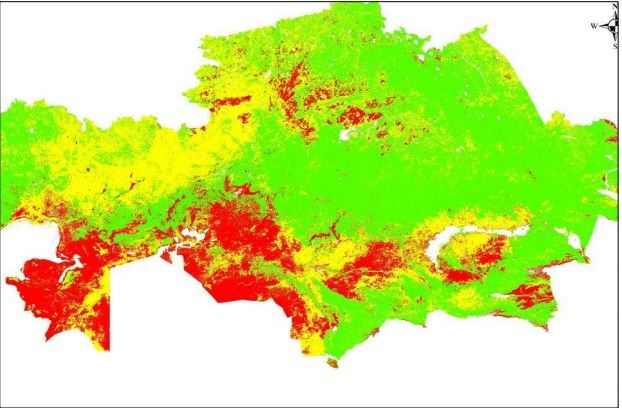
SDS vulnerability map of Kazakhstan. Taken from the National Action Plan
for Warning and Mitigation Effects of SDS for 2021-24
#Sandandduststorms #SDS #UNCCD #CAREC #DroughtandSDS #Central Asia
Because of its arid to semi-arid climate, the Central Asian region is significantly affected by drought and sand and dust storms (SDS), especially in areas outside the highlands. Assisting countries all over the world in improving their preparedness and resilience to droughts and SDS is one of the aims of the United Nations Convention to Combat Desertification (UNCCD). As part of its global efforts, the UNCCD Secretariat has developed mechanisms for promoting policies in the field of SDS management and supported the development of strategies to reduce the risks of SDS at both national and regional levels.
By initiating the project “Regional approaches in combatting sand and dust storms and drought” implemented by the Regional Environmental Centre for Central Asia (CAREC) in partnership with the appointed national institutions in Central Asian states, the UNCCD Secretariat facilitates coordination between state bodies, the academic community, practitioners and local communities in the region. Coordination and cooperation are vital as both drought and SDS are transboundary natural phenomena, which affect health and livelihood irrespective of political borders.
The Republic of Kazakhstan, with its vast and diverse territories is also prone to drought and SDS. Such natural factors as climate aridity, frequent strong winds, scarcity of vegetation in the steppes, insufficient soil moisture, low relative air humidity, frequent droughts contribute to the occurrence of SDS in the country.
In addition to natural factors, anthropogenic influence is a significant contributor to SDS. Since the early 1960’s when intensification of irrigation in the Aral Sea basin has started, significant areas of secondary saline soils and anthropogenic salt marshes have appeared. These areas are a source of salty dust, which travels across vast areas and has a profoundly negative impact on the ecosystem, environment and living conditions of the local population.
Although Kazakhstan has adopted strategic measures to combat desertification and signed a number of international declarations in the field of environmental protection, until recently there have been no separate national policies or strategies devoted to address SDS occurrence in the republic. Thanks to the efforts of experts of the Institute of Ecology and Sustainable Development, the officially appointed national institution in the Republic of Kazakhstan to work on the comprehensive National Action Plan (NAP) on Mitigation of SDS in the Republic of Kazakhstan for 2021-2024, within the “Regional approaches in combatting sand and dust storms and drought” project. Its development was initiated by the UNCCD Secretariat and became possible as a result of work carried out by the Institute of Ecology and Sustainable Development and CAREC in cooperation with the Government of Kazakhstan represented by the Department of Forests and Specially Protected Natural Areas of the Forestry and Wildlife Committee of the Ministry of Ecology, Geology and Natural Resources of Kazakhstan.
The NAP includes an overview of Kazakhstan’s current national efforts and international commitments in combatting desertification as well as a map of SDS sources and a comprehensive analysis of its sources and causes. The document reminds that building multi-country cooperation and combining efforts with existing regional initiatives and processes is vital for combatting SDS. It outlines short-term, medium-term and long-term actions that are necessary to combat SDS. Among other steps, these actions include improving the environmental management system, developing methods of assessing the different impacts of SDS, developing by-laws and national programs related to tackling SDS, organizing environmental education, protecting pastures, and many other elements.
Desertification and SDS are interrelated and multifaceted. Their occurrence is related to water availability and management of water resources, agricultural practices, soil and vegetation cover quality, climate change and biodiversity conservation. The UNCCD Secretariat recognizes the complexity of the problem and emphasizes the role of cooperation and community involvement in charting the path forward. Being vulnerable to desertification, Central Asia needs to foster large-scale cooperation between countries to tackle these issues. On the eve of June 17, the World Day to Combat Desertification and Drought, CAREC would like to stress the vital importance of combatting desertification and saving the nature for generations to come.
Information about the Project:
In January 2020, in all five countries of Central Asia with the financial support of the Secretariat of the United Nations Convention to Combat Desertification (UNCCD) the project “Regional approaches in combating sand and dust storms and drought” was launched. The project is implemented by the Regional Environmental Centre for Central Asia (CAREC), which works in close cooperation with designated national institutions and UNCCD National Focal Points in each of five countries.
The main objective of the project is to assist Member States in improving their preparedness and resilience to droughts and FDP, and to enable coordinated action and data exchange at national and regional levels.
You can learn more about the Project and its activities here:
- http://carececo.org/main/activity/projects/droughtSDS/
